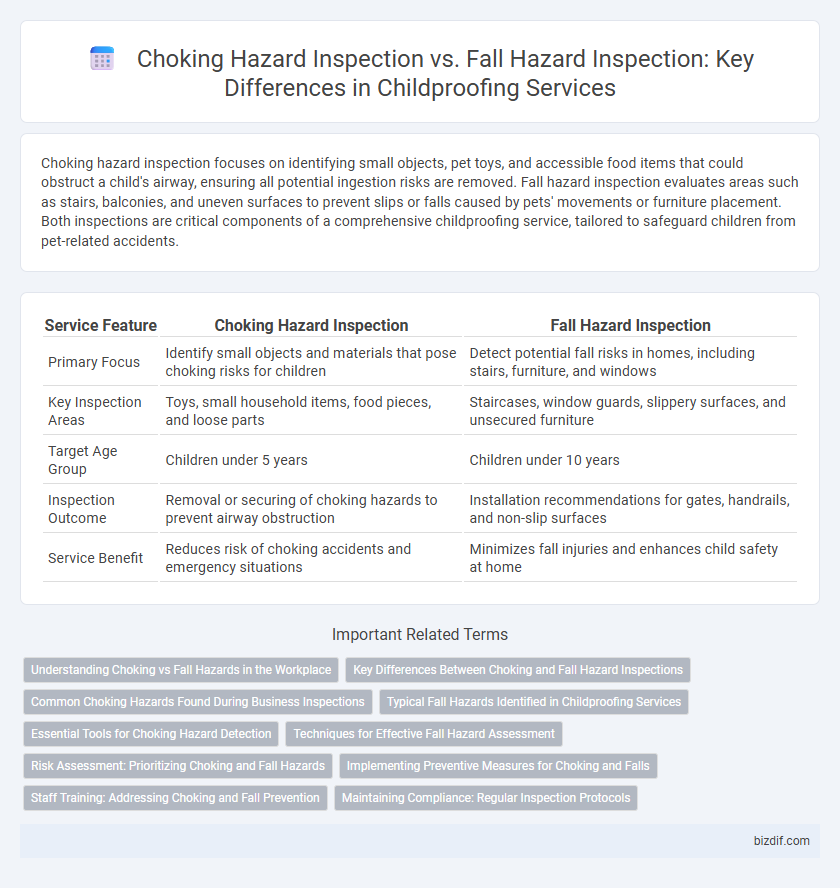Choking hazard inspection focuses on identifying small objects, pet toys, and accessible food items that could obstruct a child's airway, ensuring all potential ingestion risks are removed. Fall hazard inspection evaluates areas such as stairs, balconies, and uneven surfaces to prevent slips or falls caused by pets' movements or furniture placement. Both inspections are critical components of a comprehensive childproofing service, tailored to safeguard children from pet-related accidents.
Table of Comparison
| Service Feature | Choking Hazard Inspection | Fall Hazard Inspection |
|---|---|---|
| Primary Focus | Identify small objects and materials that pose choking risks for children | Detect potential fall risks in homes, including stairs, furniture, and windows |
| Key Inspection Areas | Toys, small household items, food pieces, and loose parts | Staircases, window guards, slippery surfaces, and unsecured furniture |
| Target Age Group | Children under 5 years | Children under 10 years |
| Inspection Outcome | Removal or securing of choking hazards to prevent airway obstruction | Installation recommendations for gates, handrails, and non-slip surfaces |
| Service Benefit | Reduces risk of choking accidents and emergency situations | Minimizes fall injuries and enhances child safety at home |
Understanding Choking vs Fall Hazards in the Workplace
Choking hazard inspection identifies small objects, loose parts, and food items that pose a risk of airway obstruction, particularly for children in the workplace. Fall hazard inspection targets uneven surfaces, unsecured rugs, stairways without railings, and cluttered pathways that increase the likelihood of slips and falls. Understanding the key differences between choking and fall hazards ensures comprehensive childproofing that addresses both ingestion risks and physical injury prevention.
Key Differences Between Choking and Fall Hazard Inspections
Choking hazard inspections focus on identifying small objects, toys, and food items that pose ingestion risks to children, emphasizing areas like playrooms and kitchens. Fall hazard inspections evaluate structural safety elements such as stair gates, window guards, and slippery surfaces to prevent injuries from falls. Both inspections aim to enhance child safety but differ primarily in their hazard types and preventive measures.
Common Choking Hazards Found During Business Inspections
Common choking hazards found during childproofing business inspections include small toys, loose buttons, coins, and unsecured food items like grapes and nuts. Inspectors identify potential risks in play areas, retail spaces, and dining zones where children frequent, ensuring all items are appropriately sized or removed. Regular choking hazard assessments significantly reduce emergency incidents and enhance overall child safety in commercial environments.
Typical Fall Hazards Identified in Childproofing Services
Typical fall hazards identified in childproofing services include unsecured furniture, missing stair gates, and slippery surfaces that increase the risk of injury. Inspectors also target exposed stair edges, windows without guards, and cluttered walkways that can lead to dangerous trips and falls. Addressing these common fall risks ensures a safer environment for children by minimizing potential accidents in the home.
Essential Tools for Choking Hazard Detection
Essential tools for choking hazard detection in childproofing include small object detectors, specialized vacuum devices to identify tiny debris, and visual inspection aids such as magnifying glasses or bright LED flashlights. These tools help uncover potential choking risks like loose toy parts, small household items, or food fragments hidden in crevices. Unlike fall hazard inspections that focus on securing furniture and installing safety gates, choking hazard detection requires precision tools to identify and eliminate minute objects within a child's reach.
Techniques for Effective Fall Hazard Assessment
Effective fall hazard assessment in childproofing involves thoroughly examining staircases, windows, and slippery surfaces for potential risks. Techniques include using safety gates, installing window guards, and securing rugs with non-slip pads to prevent slips and falls. Regular maintenance and professional evaluations help ensure that fall hazards are minimized to protect children from serious injuries.
Risk Assessment: Prioritizing Choking and Fall Hazards
Choking hazard inspection targets small objects, toys, and accessible food items that pose ingestion risks to children under five, emphasizing the identification of high-risk materials and environments. Fall hazard inspection evaluates furniture stability, window guards, stair safety, and slippery surfaces, focusing on preventing injuries from elevated areas and sharp edges. Prioritizing these risks requires a comprehensive assessment of the child's age, mobility, and environment to implement effective childproofing measures that minimize both choking and fall dangers.
Implementing Preventive Measures for Choking and Falls
Implementing preventive measures for choking hazards involves thorough inspection of small objects, toys, and accessible food items to ensure they do not pose a risk to children under three years old. Fall hazard inspection focuses on securing furniture, installing safety gates, and cushioning sharp edges to prevent injuries from slips and falls within the home environment. Both inspections prioritize creating a safe living space by identifying and mitigating specific risks associated with young children's natural curiosity and mobility.
Staff Training: Addressing Choking and Fall Prevention
Staff training for childproofing services emphasizes identifying choking hazards such as small objects, toys with detachable parts, and food items, while also focusing on fall prevention by inspecting stairways, window guards, and slippery surfaces. Comprehensive education equips staff to implement safety measures, conduct hazard assessments accurately, and communicate preventive strategies to caregivers. Effective training reduces injury risks by ensuring vigilant monitoring and proactive intervention in environments frequented by children.
Maintaining Compliance: Regular Inspection Protocols
Choking hazard inspection focuses on identifying small objects and accessible items that could obstruct a child's airway, while fall hazard inspection evaluates structural risks such as unsecured furniture or unprotected staircases. Maintaining compliance requires adhering to standardized safety checklists and scheduling regular inspections to promptly address emerging dangers. Consistent documentation and corrective action ensure ongoing adherence to child safety regulations and prevent potential injuries.
Choking hazard inspection vs Fall hazard inspection Infographic

 bizdif.com
bizdif.com